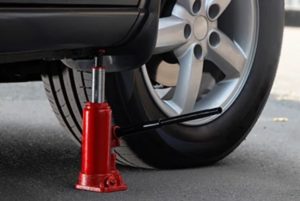
Like many others, you may well have a jack in the boot of your car, but this is considered a man-powered device, designed to lift your vehicle in the event of an emergency or breakdown.
On the other hand, Hydraulic jacks tend to be found in more industrial environments, such as workshops and garages.
These tools generally come under heavier-duty products, while still primarily used on cars and other vehicles, and have a far wider range of uses than standard mechanical jacks – for example, hydraulic jacks are also sometimes used to lift building foundations during construction projects.
Types of hydraulic jacks
The two common types of hydraulic jacks are bottle jacks and floor jacks.
Bottle Jacks
Bottle jacks have been popular since the early 1900s when the automobile industry began to take off. Sometimes, also named as hand jacks. Bottle jacks provided an easy and simple way for an individual to lift a vehicle for roadside inspection or service.
You might have noticed that the design of the hydraulic bottle jack resembles a milk bottle, thus it has earned the name of bottle jacks today. Like other tools, they also range in size and lifting capacity from one hundred pounds to several tons.
As they are most commonly used in the automobile industry, (1.5 to 5-ton jacks are considered the range of capacities typically used to lift cars).
Plus, bottle jacks have other uses as well. In the medical industry, they are usually used in hydraulic stretchers and patient lifts. In industrial applications, they are found as pipe benders used in cable slicers for electrical projects, in plumbing, and material lifts within warehouses.
Floor Jacks
Now let’s discuss the floor jack, Bottle jack shafts operate vertically, whereas the shaft in a floor jack is horizontal, the shaft pushes on a crank that further connects to a lifting pad, which is then lifted vertically.
Floor jacks normally provide a greater range of vertical lift than bottle jacks and are also available in two sizes. The original jack is about four a foot wide, feet long, and weighs almost 200 pounds, they are capable of lifting 4-10 tons.
A more compact model of a flock jack was later introduced, which is around three feet in length and can lift 11/2 tons. Although Minijacks are also produced, it is important to know that they are not categorized as a standard type of floor jack.
How does exactly a hydraulic jack works?
While working with a hydraulic jack, you will need to insert the metal pumping bar into the handle socket and pump it.
Further, it will push the ram up and raises the boom with a load attached to the end. In order to lower a load, you will be required to open the bleed valve located on the base of the jack.
But the real question is, what happens inside of the cylinder when working a jack?
Well, the thing is that the same Pascal’s principle is being used to lift a load. When the user activates the pumping system by inserting the pumping bar into the handle socket and then pumping it, the hydraulic fluid (oil) is pushed forward to the cylinder through a one-way valve which then applies pressure to the fluid while filling the cylinder.
The aspect to consider is that fluid can only flow back from the cylinder through another valve which is always blocked by a steel ball, In order to open it, you need to unscrew the bleed valve located at the bottom of the ram.
As the one-way valve does not allow the fluid to move back, it leads to pressure in the cylinder, while the jack is being pumped.
Now, the pressure inside the cylinder exerts out force and lifts the piston and the ram upwards which helps to lift heavy loads by continuously applying small force in the small cylinder, which is even multiplied in the larger cylinder.
Well, basically the larger the cylinder is, the more weight could be lifted, which enables lifting very heavy loads just simply using a hand pump mechanism.
Specifications for jacks and hydraulic jacks
All types of jacks including hydraulic jacks are typically specified by several key specifications which are mentioned below. Please note that these parameters vary by jack type and may also vary from brand to brand.
- Travel length: this represents is the maximum distance over which the lift pad or ram will gradually travel or move from its un-extended position to its fully extended position.
- Capacity: indicates the maximum load that the jack is capable of holding, it is usually expressed in tons or pounds.
- Maximum lift height: this represents the displacement of the jack’s ram or lift pad or largest distance when the jack is in the fully extended position measured to a reference surface.
- Handle length: it’s simply the overall length of the handle for raising and lowering the jack.
- Power source: well this is an important specification as it indicates the mechanism by which the jack is operated, such as air, manual or for example, battery, pneumatic, or electric.
- Working orientation: this aspect indicates the intended use orientation for the jack (horizontal or vertical) which is based on the design of the unit.
Conclusion
Well, hydraulic jacks are capable of lifting heavy loads but require proper and consistent maintenance to prevent the development of problems with the hydraulic components that could possibly endanger operators, for example, problems with the cylinders that provide assistance in generating the lifting force.
- Craftsman Jack Stands Review - October 18, 2022
- OTC 1545 Motorcycle Lift Review - October 18, 2022
- Pro Lift Jack Stand Review - October 17, 2022
